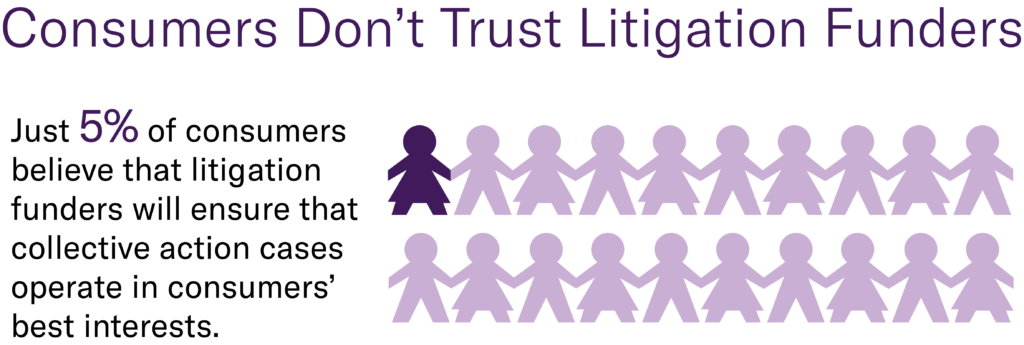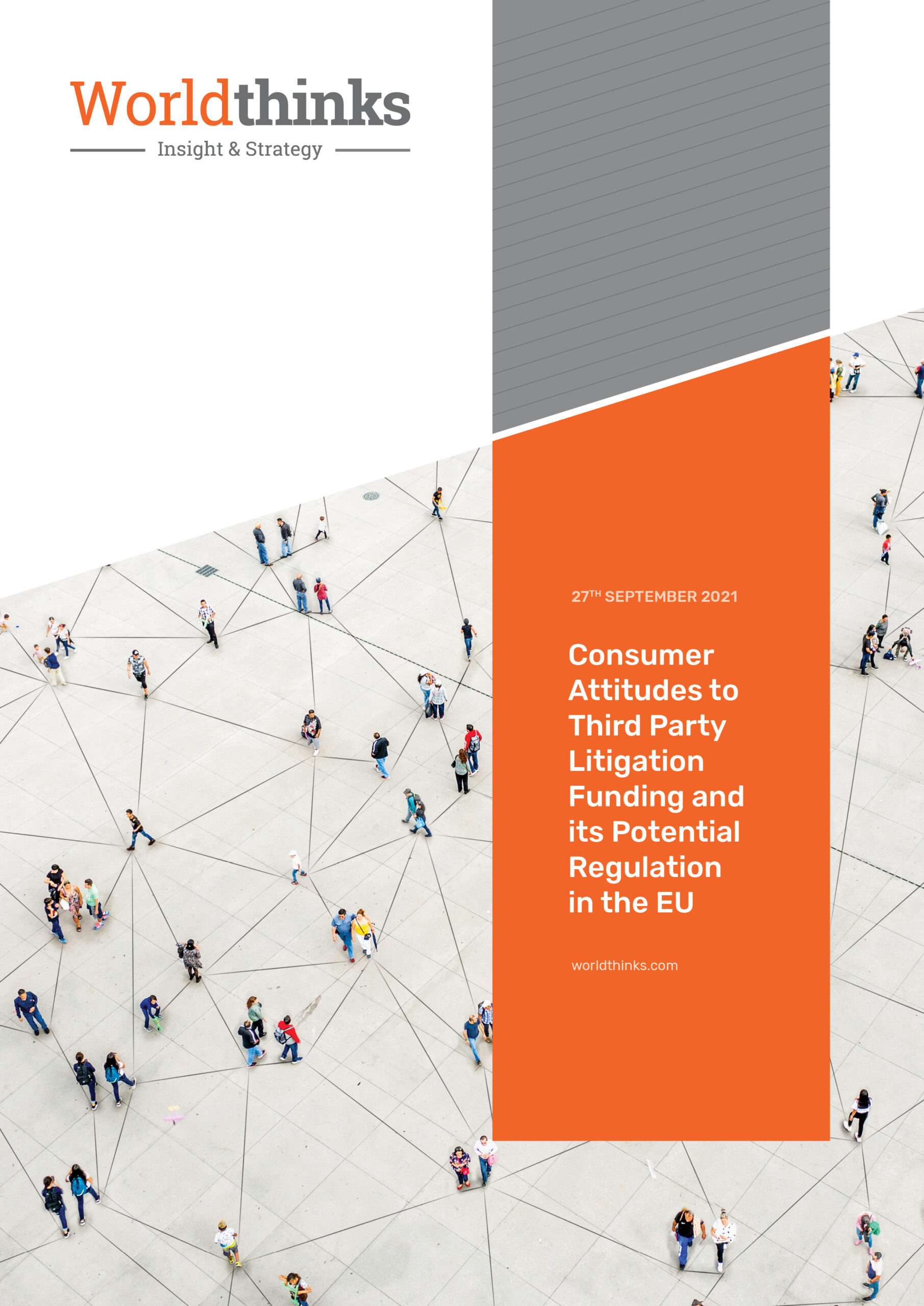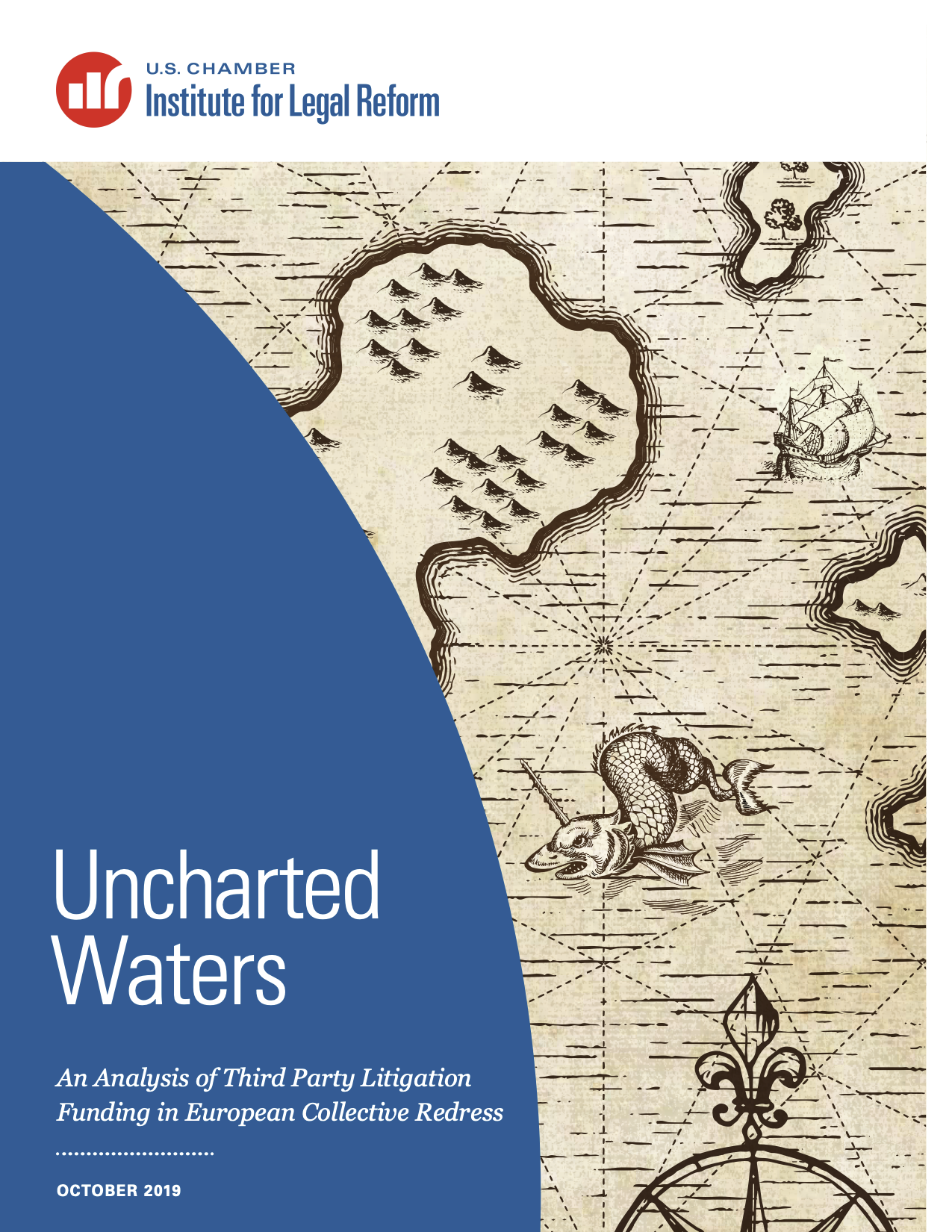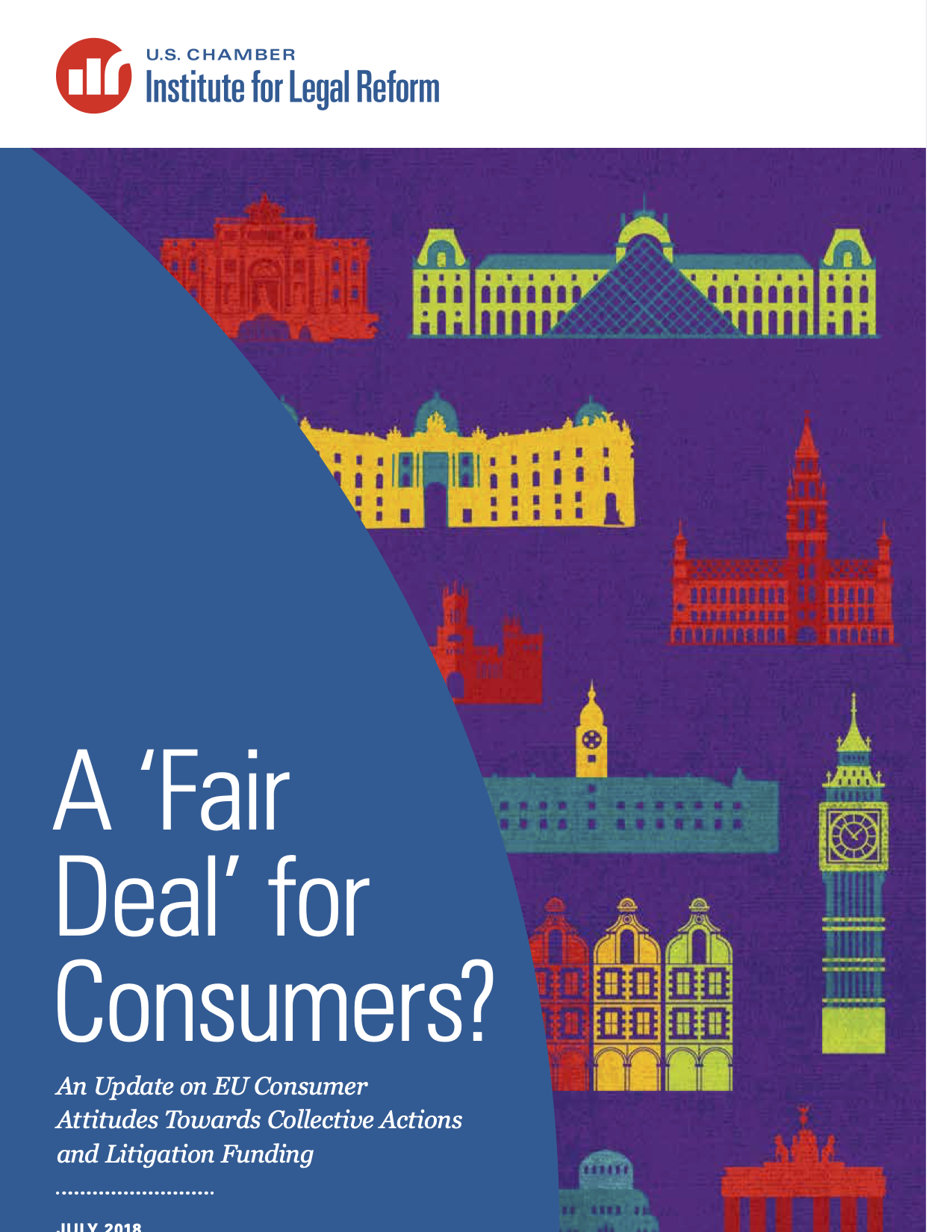The U.S.-style litigation culture is expanding globally. ILR responds where it matters most by championing balanced legal systems to avoid the American lawsuit system’s costliness and wastefulness in places like the UK and the EU.
On this page, you will find information regarding international litigation trends, ILR’s legislative and policy work internationally, as well as research reports, podcast episodes, news articles, and blogs on this topic. Check back often to ensure you never miss the most up-to-date information.
International Litigation Glossary
Collective or Class Action Under the Representative Actions Directive (RAD)
A legal action for the protection of the collective interests of consumers under the EU Representation Actions Directive is brought by a “Qualified Entity” as a claimant party with standing on behalf of consumers aiming at an injunction measure or a redress measure, or both.
Qualified Entity (QE)
Any non-governmental organization or public body representing consumers’ interests that has been formally designated by a Member State as qualified in accordance with the Directive. QEs have the rights and the obligations of a claimant party in a proceeding.
EU Member States designate QEs for both “domestic” and “cross-border” actions. The distinction between domestic and cross-border actions depends only on the place of the QE designation and the place of the legal action.
While the RAD imposes a set of strict “criteria” or qualification standards for QEs engaged in cross-border actions, it does not regulate criteria for QEs engaged in domestic actions.
Domestic Representative Action
A domestic representative action (under the RAD) is brought by a QE in the Member State in which it is designated.
Cross-border Representative Action
A cross-border action (under the RAD) is brought by a QE in a Member State other than that in which it is designated. Any other cross-border elements, such as the place of residence of the represented consumers or the location of the defendant, are not considered in this distinction between domestic and cross-border actions.
Opt-in Action
An action in which consumers must explicitly express their consent to be represented within a representative action.
Opt-out Action
An action in which consumers do not have to explicitly express their consent for them to be represented within a representative action.
Forum Shopping
The ability for claimants to select among various jurisdictions in bringing their claims, and to choose whichever forum they deem more favorable.
Punitive Damages
A monetary award granted for the purposes of sanctioning or deterring defendants, or rewarding claimants, rather than restoring consumers to their pre-infringement position.
Class Certification
A procedural process during which the court determines whether a collective action in the best possible mechanism for resolving the claims.
Third Party Litigation Funding/Financing (TPLF)
Third party litigation funding is a commercial practice whereby third-party entities (e.g., hedge funds or sovereign wealth funds) invest in lawsuits for profit, typically in exchange for a percentage of any settlement or judgment. Learn more about TPLF here.
Contingency Fees
Fees based on the outcome of the case. The most common form is a ‘no-win, no-fee’ arrangement, in which a lawyer takes no fee (or a low fee) if the case is lost and is paid a share of any award if the case succeeds.
Cy Près
When it is difficult to identify those harmed, or when it is economically inefficient or logistically challenging to distribute damages directly to those harmed, these ‘excess,’ ‘unclaimed,’ or ‘undistributed’ damages are instead given to representatives, lawyers, funders, or even unrelated third parties.
EU Representative Actions Directive
The EU Representative (Collective) Actions Directive was officially adopted by the European Union in 2020. The Directive requires each Member State to establish a collective action system to allow consumers to sue for damages. While the Directive contains some safeguards to prevent abusive litigation, it does not go far enough, and clever profiteers could exploit its loopholes.
Member States had two years to transpose the Directive, with a deadline of June 2023. So far, 17 Member States have finalized their national laws. The remaining national governments are still determining crucial features of their country’s redress system, such as how much control third party litigation funders will have over a claim and whether consumers will have the opportunity to consent to be part of a lawsuit.
This is an opportunity for policymakers to improve the Directive with much-needed safeguards for consumers and businesses. They should take heed of the advice given here and resist the siren calls of litigation entrepreneurs and speculators.

12 Suggested Safeguards
The EU Representative Actions Directive mandates that Member States have a collective action system in place for consumers to seek redress for breaches of certain EU laws. However, the Directive leaves many of the implementation details up to the Member States’ discretion.
Member States must find an appropriate balance between facilitating fair redress and safeguarding against opportunistic litigation. Member States should consider the following recommended safeguards as the minimum necessary for any collective consumer action, whether domestic or cross-border, and whether inspired by the Directive or in a pre-existing or subsequent regime.
The following is a list of 12 suggested safeguards:
1. ‘Domestic’ Qualified Entities should be subject to the same criteria as ‘cross-border’ QEs.
2. ‘Grandfathered’ Qualified Entities should also comply with the Directive’s criteria.
3. Member States should insist on opt-in mechanisms.
4. A strong certification procedure should be put in place.
5. Public information systems about representative actions should be closely supervised to ensure they are not used to force settlements from defendants.
6. Contingency fees should be prohibited.
7. Additional safeguards for TPLF should be considered.
8. Parties to a collective action should be incentivized to settle.
9. Punitive damages should be prohibited.
10. Payments of ‘undistributed damages’ should be prohibited.
11. Disclosure or discovery obligations should be proportionate to the needs of the case.
12. Alternative Dispute Resolution (ADR) mechanisms should be at the heart of any domestic or cross-border regime to provide consumers with fair, simple, inexpensive, and speedy redress.
To find out more, look at our 12 Recommendations for the Implementation of the EU Directive on Representative Actions.

Product Liability Directive
The Product Liability Directive (PLD) is the foundation of the EU product liability regime. It was adopted nearly 40 years ago and during that time has provided a largely effective compensation mechanism for those who suffer damage caused by defective products in the EU.
Maintaining a fair balance of interests between consumers and producers has been viewed as the main objective of the PLD since the day of its adoption. Unfortunately, when the European Commission set out to revise the PLD to consider new technologies, like AI and digital services, they ended up proposing a full upheaval of the product liability regime. This new regime will place a substantial liability burden on companies, hampering their ability to innovate and disincentivizing manufacturing in Europe.
As currently drafted, the revised PLD allows for non-material damages for data loss and psychological harm, which are notoriously challenging to quantify. It also expands disclosure or discovery rules without essential safeguards. It also reverses the traditional burden of proof and does away with the monetary threshold on claims that, until this point, have effectively prevented an overabundance of small claims that could clog courts and disproportionately affect small and medium-sized enterprises (SMEs) that do not have the resources to cover expensive legal fees.
The EU is planning that the revised PLD will be included in the scope of the EU’s Representative Actions Directive (RAD), meaning that it will be possible to bring national or even cross-border class action claims for alleged defective products. It is likely there will be a significant uptick in product liability litigation across the EU. Businesses could be discouraged from investing in new technologies or bringing these technologies to the EU.
When implementing the revised PLD, Member States will have to consider very carefully their national policies and procedures on product liability and not leave the door open for abusive litigation that will hamper innovation while providing little if any benefit to consumers. The revised PLD should strike a fair balance between the needs of consumers and producers.
UK Litigation Landscape
Over the past decade, plaintiffs’ lawyers and litigation funders have imported some of the worst practices of the U.S. lawsuit system in the UK. The UK litigation landscape has seen an alarming rise in class or group actions against businesses.
According to UK advocacy group Fair Civil Justice, a predatory litigation culture harms consumers, employers, and Great Britain. Litigation is extremely expensive for all parties. Consumers pay for their lawyers via deductions to their settlements and damages awards, even under “no-win/no-fee” arrangements. The only beneficiaries are the lawyers and litigation funders.
The growth in class actions can be attributed in part to the exponential growth of TPLF in the UK. Financiers are increasingly investing in “opt-out” class action style lawsuits, which target large companies like tech and others. Opt-out class actions are a type of lawsuit in which an individual can be included as a plaintiff without their knowledge and must proactively “opt-out” of the larger class action lawsuit. One UK class action, which was the biggest “opt-out” style lawsuit, was brought on behalf of 46 million British consumers (more than half of the UK population) in a case against a credit card company.
Third Party Litigation Funding is a Growing Threat
TPLF allows private financiers, like hedge funds, private equity firms, endowments, and even sovereign wealth funds, to sign confidential deals with law firms or claimants’ representatives to fund lawsuits in exchange for a share of any settlement or award. Funders prioritize their bottom-line interests over the interests of the claimants and can arrange to be paid first and take a disproportionate share of any award, leaving claimants who suffered harm with little or no redress.
TPLF is growing exponentially around the world, with some estimating the global litigation market to be worth anywhere from €40 billion to €80 billion. The European Parliamentary Research Service reports that the TPLF industry grew by 40% in the EU between 2009 and 2019, and is projected to grow even faster this decade, potentially doubling in size over the next five years. According to research, eighty-three percent of EU consumers support the introduction of safeguards to ensure cases funded by TPLF operate in consumers’ best interests.
On 13 September 2022, the European Parliament adopted a legislative own-initiative (INL) report, or resolution, on responsible private funding of litigation, known as the Voss report. The Parliament resolution, which was adopted by an overwhelming majority (80%) calls on the European Commission to propose a TPLF directive, which would put in place fair and proportionate regulation of TPLF in the EU. The report’s oversight measures for litigation funders include:
- Licensing by an independent supervisory authority in the Member States.
- Capital adequacy requirements.
- An obligation to pay adverse costs (loser pays rule).
- A duty to act in the best interests of claimants.
- A requirement to inform the court and defendant of the existence of funding behind a claim and the identity of the funder.
- Disclosure and review of the complete and unredacted copy of the funding agreement by the court or administrative authorities.
- Assessment of the funders’ fees by courts or supervisory authorities to determine if their share of any award is fair and proportionate (no more than 40% of the award can go to funders, and claimants must be paid first).
- No undue funder control over the proceedings, both formally through contractual agreements and informally through threats to withdraw funding.
- A prohibition on withdrawing funding without the claimant’s informed consent.
- Strong safeguards against conflicts of interest.
The European Commission and Member States should propose fair and proportionate regulations in line with those to which all other financial industries adhere. Consumer and public confidence in funders will only increase with transparency and government oversight.
International Research
The Institute for Legal Reform’s research program is cutting-edge. We examine the most pressing civil justice issues facing legal systems across the world. We work with some of the world’s foremost legal experts to offer insights and potential solutions for a more just legal system.
This ILR survey report finds that European consumers do not want lawsuit finance companies to invest in civil litigation without oversight. They strongly support a variety of proposed safeguards to keep TPLF in check.
TPLF involves companies making often-secret deals with lawyers to fund lawsuits in exchange for a cut of any judgment or settlement. Currently, those companies operate under a near-total lack of regulation and transparency in the EU and around the world.
83 percent of those surveyed support the introduction of safeguards to ensure cases funded by TPLF operate in consumers’ best interests, and between 66 and 79 percent support a range of specific proposed safeguards. Among the top polled safeguards are proposals that:
- Funders should have a fiduciary duty to put the best interests of claimants over their own investment interests (79 percent).
- Funders should be legally required to see a case through until the end without the ability to withdraw their funding before a case is concluded (78 percent).
- Funding agreements should be subject to an independent review to ensure they are not written unfairly in favor of the funders (78 percent).
Read Consumer Attitudes to Third Party Litigation Funding and its Potential Regulation in the EU to learn more.
In the ILR’s research titled The Future of AI Liability in the EU, the paper addresses the potential for AI to advance innovation while acknowledging legitimate safety concerns in the European Union.
Machine learning and autonomous decision-making reduce human control by definition and, for that reason, create a myriad of ethical, legal, and practical concerns. As the EU comes to terms with these concerns, it is rightly asking:
- What role should the EU play in encouraging or limiting the ways in which AI may develop?
- Does the EU intend to lead or follow?
- How should a desire to promote bold innovation be balanced against the need to protect consumers?
- And how well-suited are traditional concepts of liability when machines, not people, will make decisions?
The impact of any EU legislation on AI is potentially vast. Any legislative measures will likely affect broad swathes of consumers and industry, including any businesses active in the AI space that sell their products or services to EU customers.
This ILR research paper breaks down the various elements of the Commission’s emerging position on AI and offers a set of guiding principles for the development of a balanced, flexible, and future-oriented AI liability regime founded on concrete evidence and a careful cost/benefit analysis. These principles include:
- Taking stock of existing EU measures and industry best practices.
- Favoring “soft” measures, not overzealous regulation.
- Consulting with stakeholders and adopting a participative regulatory approach.
- Coordinating with other institutions and governments.
- Promoting evidence- and risk-based regulations.
- Adopting reasonable constraints on liability.
Read The Future of AI Liability in the EU to learn more.
Third party litigation funding (TPLF) has become a highly debated topic in jurisdictions around the world. Legislators in Europe, North America, Asia, and Australia have struggled to understand exactly what TPLF is and how it works, as well as the potential for abuses that undermine the advantages of this instrument that is purported to ease access to justice. This is true particularly in collective redress proceedings.
This ILR research paper details the spread of TPLF in the EU and around the world and breaks down how regulators in a number of countries are grappling with the challenge that the industry poses for the transparency and integrity of their civil justice systems. The research also urges EU legislators to take up several specific reforms to protect consumers and businesses, including:
- A requirement to disclose funding arrangements to courts and possibly to all parties to litigation.
- Measures empowering courts to resolve conflicts of interest between funders, attorneys, and parties to litigation.
- Rules establishing the court’s ability to prevent funders from exerting excessive influence over the course of litigation.
Read Uncharted Waters: Analysis of TPLF in European Collective Redress to learn more.
Collective redress or collective actions are a form of civil litigation used to group together claimants, often consumers, who have all allegedly been harmed in the same way. These lawsuits are similar to ’class actions‘ commonly used in the United States. Some form of collective redress can now be found in almost every Member State of the European Union (Member State). On April 11, 2018, the European Commission released a comprehensive consumer protection policy package known as the ’New Deal for Consumers’. This package contains a proposal for a directive on representative actions, which would introduce an EU-wide system for consumer collective actions.
This survey report revealed that:
- Only 13 percent of European consumers support the proposal as currently drafted.
- 67 percent agree that without the introduction of safeguards, the European Commission should not introduce collective actions in the EU.
- 82 percent agree that collective action safeguards should be made consistent across the EU.
In addition, significant majorities of EU consumers expressed support for specific safeguards not currently included in the proposal. These safeguards would:
- Ensure consumers “opt-in” to these cases rather than allow lawyers to include consumers in lawsuits without their knowledge (77 percent).
- Require cases to meet some minimum standards before a judge will allow them to go forward (75 percent).
- Obligate parties in the dispute to show they have tried to resolve their differences before bringing a lawsuit (74 percent).
- Mandate that only legitimate consumer interest groups can initiate cases (65 percent).
- Require that all third party litigation funders be accredited or licensed and overseen by a government agency (72 percent).
Read A ‘Fair Deal’ For Consumers? An Update on EU Consumer Attitudes Towards Collective Actions and Litigation Funding to learn more.
You can find all of ILR’s research on our Research page.
International Blogs
Want to learn more about International Issues? Check out some of our blogs.
For more ILR blogs, visit our blogs page.
International Podcasts
ILR’s award-winning podcasts features episodes on international initiatives.
For more episodes of ILR’s Cause for Action Podcast, visit our podcast page or subscribe wherever you listen to podcasts.



